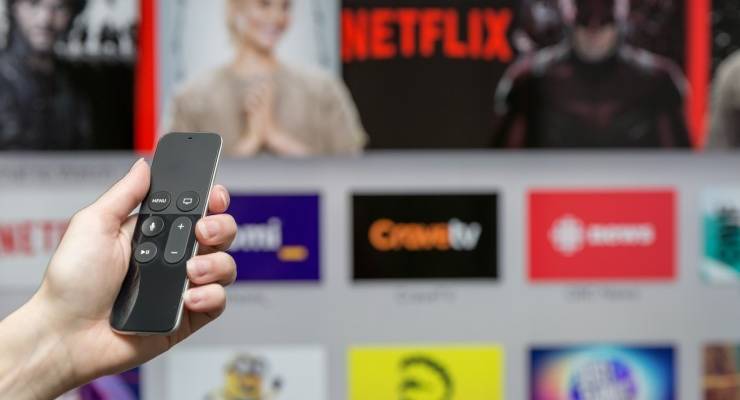
Australians will likely be paying more for TV drama and, increasingly, sport, as program makers pull their shows from streaming platforms and sell exclusively direct to consumers.
As enthusiastic adopters of subscription video on demand, Australians are an early target for this likely shift to multiple providers. In announcing the launch of its Disney+ streaming service in Australia, Disney has fired the opening shot in the local front of the streaming war between the distributors of content bundles — like Netflix, Foxtel and Stan — and individual production companies. Other major US companies are following Disney — WarnerMedia later this year, and NBCUniversal in 2020. They’re all competing for subscription dollars and for that most finite of resources: users’ time.
It’s a war that sets the producers against the distributors. The producers have to pivot from business-to-business sales to the more complex direct-to-consumer model.
The big tech companies are buying in as well, with streaming video platforms (such as Apple TV) looking to aggregate streaming services (along with some of their own content as well). Amazon is spanning the field with production, distribution and platform.
These challenges make it hard to see how Australia’s local bundles (Stan, Foxtel) can compete at the scale required, despite Nine’s announced content deal with Paramount and the confident claim in its end-of-year financials last week that Stan is heading for profit after annual revenues of $157 million last year.
Size matters. When Disney needed streaming technology, it went out and bought what it needed, paying about $4 billion for the allegedly state-of-the-art BAMTech. On the distributors’ side, Netflix is committed to spending about $15 billion this year on producing its own content as the US producers are setting deadlines for pulling their popular shows like Friends or The Office off the service. Still, that equals only 40% of Disney’s overall content spend.
The big losers are the cable operators. Companies like Foxtel are stuck with capital intensive distribution infrastructure being cannibalised by their own streaming services.
Nine is banking on the continued attraction of its bundle, reporting that Stan had climbed to 1.7 million subscribers (out of about 10 million households in Australia). It’s close to catching Foxtel’s residential numbers — about 2.1 million households according to News Corp’s end of year filings with the US Securities and Exchange Commission. Foxtel also reports 264,000 commercial subscriptions (all those screens in bars, gyms and hotels) and about 750,000 paying subscribers to its streaming services Foxtel Now and Kayo.
The sleeper is Optus Sports with the rigorously unbundled Australian rights to English and European soccer. Their claimed 700,000 subscribers — twice the level of Foxtel’s Kayo — shows the value of a specialised, committed niche.
However, Netflix overshadows all: consumer site Comparitech says this global first-mover bundle is now in about half Australian households, producing revenues over $2 billion and putting Australia behind only the US in the company’s income stream.
Prices are creeping up as services become must-haves: Stan at $17 a month, up $2 this year; Netflix, at $17.99 (also up this year); and Optus Sport at $14.99. Disney+ at $8.99 a month looks priced as both a second service and replacement for the dollars that parents already pay for Disney videos (an estimated $4.5 billion in the US).
These offerings leave Foxtel at a relatively uncompetitive $25 a month (for the cheapest stream) up to $98 for the premium pay tv product (plus plenty of ads). It’s attempting to compete by being part-platform (recently including Netflix access) and part-exclusive, particularly in major Australian sports like cricket and rugby league.
Ultimately, cost is less constraining than time where both creators and distributors compete with free-to-air TV and free platforms like ABC’s iView and SBS On-Demand. Oh, and then there’s those real time burners: the advertising-supported YouTube and the recently-launched Facebook Watch.








It will be interesting to see how Disney streaming goes in Australia. Their catalogue is clearly aimed at children and the ‘family entertainment’ market and $9.00 per month is cheap babysitting. Also, they have a content catalogue that has been ninety years in the making.
On the other hand, a lot of this content is dated, especially in terms of social outlook. Plus, its worldview leans strongly towards US cultural values. Having the kids play ‘Brave’ on autorepeat until the DVD wears out is one thing. Having the whole catalogue available 24/7 is another and not, I think, for the better.
I doubt that Netflix get the material they stream to paying customers, for free.
However it seems that the empire built upon a mouse (originally drawn by somebody other than the eponymous Walt) is not rich enough and wants to squeeze the customer further.
WHilst it may be better in the future and reduce some of the very irritating duplication if one has for instance, Netflix and Stan, I suspect people will begin to baulk at paying a Disney Tax or similar.
Anticipate an uptick in streaming of “off license” material in the future.
The “consumer” can always stop consuming and hit the gougers where it hurts the most.
I haven’t even got to cable yet and now you tell me it’s DoA?
Next you’ll be telling me that the DVD machine thing I’m saving for will also be on the scrapheap!
Not only that but you’ll have trouble getting replacement needles for the gramophone.
I must be the last Foxtel full subscription. If I cancel my subscription Foxtel will probably close its doors.